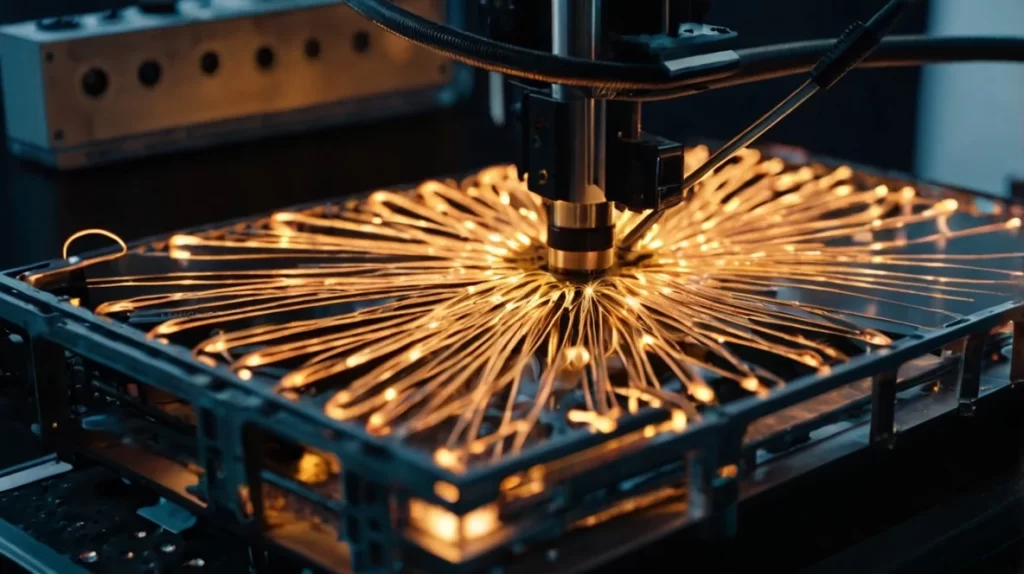The robotics industry is evolving rapidly, with increasing demand for customized, lightweight, and efficient components that integrate both mechanical functionality and electronic capabilities. Traditional manufacturing methods for robotic parts are often expensive, time-consuming, and inflexible, making it difficult to rapidly iterate and customize components for specific applications. However, with the introduction of conductive 3D printing filaments, engineers can now design and manufacture custom robotic components with built-in electrical pathways, significantly simplifying prototyping and production.
At ABC3D, we are at the heart of Industrial IoT, gathering essential data for process automation and decision-making..

The Role of Conductive Filaments in 3D-Printed Robotics
Conductive filaments are transforming how robotic systems are designed and built. Unlike conventional methods that require separate wiring, circuit boards, and assembly processes, conductive 3D printing enables the direct embedding of electrical pathways into mechanical parts. This results in simpler, more compact designs while also reducing material waste and production costs.
By using conductive-grade filaments, robotic engineers can 3D print structural components with integrated sensors, actuators, and even low-power circuitry, making robots more functional and adaptive to complex industrial environments.
Some of the key benefits of using ABC3D’s conductive filaments for robotics include:
- Eliminating Separate Wiring & PCBs – Conductive traces can be printed directly within robotic components, reducing space and assembly time.
- Lightweight, Custom Designs – Optimized for reducing material bulk, making robots more agile and efficient.
- Faster Prototyping & Iteration – Engineers can rapidly test and refine robotic limbs, grippers, and circuit-embedded frames without waiting for outsourced components.
Industrial Applications of 3D-Printed Conductive Robotics
The integration of 3D printing with conductive materials is already reshaping multiple industries by providing rapid, low-cost, and customizable solutions for robotic automation.
1. Custom Robotic Grippers & End-Effectors
Manufacturers are using 3D-printed conductive filaments to produce custom robotic hands, grippers, and soft actuators with integrated force and touch sensors. These components allow robots to adjust their grip strength dynamically based on sensor feedback, improving precision in handling delicate objects in automotive, electronics, and logistics industries.
2. Embedded Sensors for Industrial Robots
Robotic systems in automated manufacturing plants require real-time feedback to operate efficiently. Printed strain, temperature, and pressure sensors using conductive filaments allow engineers to embed monitoring capabilities directly within robotic joints and moving parts. This reduces external sensor mounting and increases operational efficiency by providing instant diagnostics on wear and tear.
3. Wearable Robotics & Assistive Exoskeletons
The development of wearable robotic suits for medical rehabilitation and industrial assistance is another area benefiting from conductive 3D printing. Flexible conductive filaments, such as TPU-based materials, enable the fabrication of bendable circuits for motion tracking, muscle stimulation, and user feedback systems within exoskeletons, making them more responsive and adaptive.
4. Autonomous Drones & Mobile Robots
Drones and mobile robots require lightweight, high-performance components to maintain battery efficiency and operational stability. By 3D printing antenna structures, EMI-shielded enclosures, and conductive motor connectors, manufacturers can improve signal transmission, reduce weight, and optimize power management in autonomous robotic systems.
Optimizing 3D Printing for Robotic Applications
To achieve the best results with conductive 3D-printed robotic components, careful consideration must be given to material selection, print settings, and post-processing techniques. ABC3D’s filaments are engineered for reliability, high conductivity, and mechanical strength, ensuring optimal performance in industrial and research-based robotics.
Here are a few key optimization tips:
- Extrusion Temperature: Conductive filaments typically require a print temperature between 220-250°C to maintain structural integrity and electrical performance.
- Print Speed & Layer Height: Slower print speeds (30-40 mm/s) and lower layer heights (~0.1 mm) improve surface resolution and conductivity consistency.
- Enhanced Conductive Traces: Increasing the width and thickness of printed traces reduces electrical resistance, improving power delivery to sensors and actuators.
- Post-Processing for Better Connectivity: Using conductive adhesives or low-temperature soldering improves external connections between printed circuits and traditional electronic components.
Why ABC3D’s Conductive Filaments Are the Best Choice for 3D-Printed Robotics
At ABC3D, we design our conductive filaments to meet the evolving needs of robotics and automation. Our materials are optimized for low-resistance electrical pathways, strong mechanical properties, and compatibility with industrial-grade 3D printers.
What makes our filaments stand out?
- High Conductivity & Mechanical Strength – Ensures reliable electrical transmission while maintaining structural durability.
- Lightweight & Customizable – Perfect for robotic arms, joints, and embedded sensor applications.
- Flexible & Rigid Options – Available in TPU for flexible circuits and ABS/PLA-based options for rigid mechanical parts.
The Future of 3D-Printed Robotics with Conductive Filaments
As robotics and automation continue to advance, 3D-printed conductive materials will play an even greater role in integrating electronics directly into mechanical systems. Future innovations will likely include multi-material printing, self-healing circuits, and AI-driven adaptive robotic designs, all made possible by the ongoing development of conductive filaments.
With ABC3D leading the way, robotic engineers, manufacturers, and researchers now have access to high-performance conductive materials that are pushing the boundaries of robotic design and automation.
Power Your Robotics Innovation with ABC3D
Whether you’re developing custom robotic grippers, autonomous drones, or next-generation industrial automation systems, ABC3D’s conductive filaments provide the conductivity, precision, and durability needed to elevate your designs. Explore our range of conductive filaments today and revolutionize your robotic applications! Need expert advice? Contact our team for tailored recommendations on optimizing your 3D printing process for industrial robotics.
